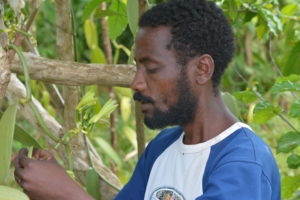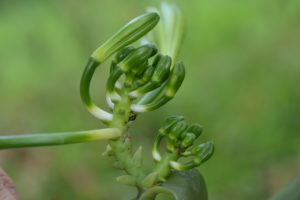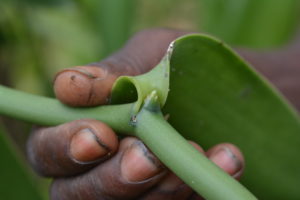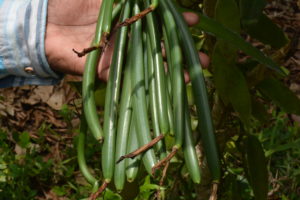VANILLA MARKET UPDATE – NOVEMBER 2017
One by one, as the hopes for a near term reversal in the market trends for the global vanilla trade are dashed, we will attempt to explain what has transpired and our perspective on the prospects for the immediate future.
Madagascar – “waiting for the inevitable”
In Madagascar, the 2017 crop is now being exported, albeit somewhat behind schedule, thanks to a government export ban on all vanilla beans through October 15th. It is still not clear what the decree’s objectives were other than to create further tension in a vanilla market that could use some respite. Since October 15th, many exporters have been playing catch up due to the pent-up demand caused by the decree, which was only strictly enforced after several exporters shipped out significant tonnage of vanilla in early September. Since the decree ended, on at least five occasions, large privately chartered air cargo planes have landed at the airport in Sambava, loading 15 – 18mt of vanilla beans per trip. This does not go unnoticed by the local community at a normally quiet, rural airport. After some early pressure leading up to the end of the export ban, prices have stabilized, but remain at very high levels, just a notch below the levels created by the post cyclone hysteria in April/May.
Although the quality of the 2017 crop is definitely better than the 2016 crop, one cannot say it is a “vintage” year by any means. Vanilla grown closer to major roads and populations is more difficult to police and often harvested prematurely. As a rule, the more rural a growing area the greater the success rate when curbing early picking and theft of green beans. Consequently, more isolated communities such as Maroantsetera and Mananara south of the Sava area have become very important areas for high quality mature vanilla beans. The level of maturity of the green vanilla is the greatest influencing factor on quality and yield for any vanilla crop. Generally speaking vanillin contents and aroma profiles should be much improved over 2016.
However, there are still significant quantities of sub-standard vanilla circulating due to early picking, early vacuum packing or even from post cyclone green beans (very immature vanilla beans blown off vines during the storm and later recuperated and cured). Even the poorest qualities of vanilla beans can find a home in the current market as buyers attempt to mitigate costs.
Crop size for 2017 is very difficult to estimate given the retention of inventory that is currently taking place all along the supply chain. Farmers hold vanilla, collectors hold vanilla and exporters hold vanilla when it seems that prices move only in one upward direction. However today, from our observations, this is occurring mostly at the collector level where most exporters are being very cautious and insisting that their customers share some of the risk via pre-financing whether the funding is needed or not. It is an understandable fact when there is exposure to such great risk.
We are quite comfortable with our initial projection of between 1300 and 1600mt for all qualities including quick cured vanilla and vanilla extracted green. Curing ratios are all over the board thus making it even more difficult to estimate crop size. Mature green beans will yield 6:1 but as we have seen in previous campaigns this will jump to 8:1 or even higher for immature vanilla.
We expect to see marked improvement in black or gourmet vanilla in 2017 as low vanillin contents in 2016 rendered these qualities very unstable due to their higher humidity levels. Although it is the demand for red extraction that drives the market, vendors will initially try to move as much black or gourmet vanilla in order to improve yields and margins. As we witnessed during the last crisis in 2001 – 2004, when prices peak there is rarely a premium demanded for black vanilla over red extraction grade beans.
Given the abundance of young vanilla vines now starting to produce beans, the flowering for the 2018 crop was expected to be strong in spite of the damage caused by Cyclone Enawo. Hence the early consensus for the 2018 crop was very bullish.
That sentiment has now changed somewhat as flowering through mid- November has been tempered as a result of two climatic factors. First, unusually cool weather in August and September followed by unusually hot and very dry weather conditions through November. Optimum flowering requires a balance of hot sunny weather and occasional rain. Otherwise flowers do not appear or they simply wilt and fall off the vine. At the time of writing this report, we understand the rains have returned to some areas of the Sava. A strong late flowering through December and January is entirely possible. It is still far too early to accurately assess the 2018 vanilla crop in Madagascar.
Industrial demand for extraction grade Madagascar vanilla remains strong enough to support the record high prices that show no signs of abating in the near term. Industrial buyers are likely to take more coverage than in 2016 given the better quality. As usual, cuts are the quality most in demand currently and have been under pricing pressure since the onset of the campaign. The spread between cuts and 1st grade beans is about 15- 20% which is very low historically. Demand for gourmet Black Madagascar Vanilla beans has dropped considerably with vanilla from Papua New Guinea now dominating the retail and institutional sectors.
Indonesia – “Too bullish…for now”.
Indonesian vanilla provided little relief to the global vanilla market in 2017 with a crop size of around 150mt. Pricing and quality have been very erratic and for the time being vendors seem content to wait for their price. We feel this strategy may backfire as improved quality from Madagascar will put pressure on Indonesian vanilla prices which are currently and inexplicably higher than Madagascar prices. Many Indonesian exporters are selling PNG vanilla and in some cases, it is being offered as Indonesian. This is unfortunate as it hurts both the Indonesian and Papua New Guinea brands. The vanillas from each of these origins is unique and have their own distinct characteristics. It is expected that the 2018 Indonesian Vanilla Production will improve over 2017.
Papua New Guinea – “Popular now …..but later”?
Papua New Guinea will see a healthy crop harvest in the first months of 2018 and could yield between 200 and 250mt. Early picking is rampant in PNG, but the larger crop should temper the practice somewhat in 2018. As buyers focus on Madagascar, PNG prices have actually softened a little, however, availability of good quality beans is scarce. The PNG Tahitensis type vanilla has helped to preserve much of the retail and food service market but not at the same levels that Madagascar enjoyed.
Too much of the PNG vanilla is smuggled through to Indonesian dealers who finance growers and collectors. However, this practice is impeding PNG exporters from growing their market share for vanilla and also adding unnecessary costs and margins.
Uganda – “Potential unfulfilled!”
Ugandan vanilla production is stalled and quality for the most part has been quite poor. Green Vanilla is harvested far too early and curing protocols are not respected. However, there is evidence that the government will take a more active role in helping the vanilla community deal with security and quality issues. This could help improve quality and crop yields going forward perhaps pushing Ugandan vanilla production above 100mt in 2018. This would be a welcome development from an origin with so much potential.
The Comoros – “Getting back in the game!”
The Comoros Islands produced between 40-50mt of Bourbon vanilla in 2017 and the quality is comparable if not slightly superior to Madagascar. The government takes a keen interest in the vanilla trade and there is an aggressive growing campaign with a goal of doubling production by 2020. The potential is here as this region has produced crop sizes of close to 200mt in the past.
Divers – “Lost origins”.
In spite of the record high vanilla prices, production in French Polynesia, Mexico and India remains insignificant with little hope for improvement over the short term. There is a lot of talk coming out of India concerning future crops and this cannot be taken lightly, however, to date there has been little evidence of improved production or quality for Indian vanilla beans.
Social Issues – “When convenient”.
The issue of child labor in the Madagascar vanilla industry continues to be a source of concern which is understandable given the exploitation of children that has already been documented in the sex trade and in the gem mines in the south. A major study undertaken by the ILO (International Labor Organization) in 2011 came to several conclusions, one of which exonerated vanilla exporters from employing children.
https://www.ilo.org/wcmsp5/groups/public/—africa/—ro-addis_ababa/—ilo-antananarivo/documents/publication/wcms_520913.pdf (Pages 53 – 56)
However, with extremely high vanilla prices even more family members are being drawn into the farming of vanilla as a form of security. Alternatively, when prices for vanilla are very low sometimes children are employed to cut costs as they are paid significantly less than adults.
The U.S. Department of Labor is now funding the ILO for a new project to further sensitize the vanilla communities of the Sava. The ILO is working closely with the Sustainable Vanilla Initiative (SVI) in order to achieve 4 primary goals in this important agenda.
https://www.ilo.org/wcmsp5/groups/public/—ed_norm/—ipec/documents/newsitem/wcms_543601.pdf
According to the ILO child labor is restricted to the farming areas and is practically non-existent at the exporter level. In most cases it is children helping out on the family farm, typically seen n in farming households around the world.
Ideally these children should have access to at least a primary education but sadly there is an acute shortage of primary schools in the rural areas of Madagascar.
We commend the SVI for this initiative but we would also like to see them address the very unsustainable practice of quick curing and green vanilla extraction. Practices that
not only degrade the overall quality of vanilla, but also threaten the livelihoods of families in the vanilla regions and by extension the children of these families who rely on vanilla for employment during the curing season for traditional vanilla. Some of the SVI’s most prominent members are actively supporting quick cured vanilla or green vanilla extraction. In our opinion this directly contradicts the 3 admirable objectives given as the mission statement for the SVI.
https://sustainablefoodlab.org/initiatives/sustainable-vanilla-initiative/
We strongly believe that Madagascar must do whatever it can to maintain its quality standards for vanilla and in our opinion, this can only mean vanilla beans cured by traditional methods. Traditionally cured vanilla provides maximum economic benefit for the farming communities while at the same time cementing Madagascar’s reputation as the world’s leading producer of high quality vanilla beans. In order to satisfy all end users of vanilla beans, in our opinion it is critical that the full array of Madagascar vanilla grades be made available. Black Gourmet Beans, Red Split and Whole vanilla beans, European Grades, Cuts, etc. all have their own market and end users. Quick cured vanilla or green vanilla extraction simply does not allow for this.
Conclusion – “Either way a challenge”.
Although the vanilla market remains as unpredictable as ever we see little likelihood of a price collapse in the near term. The question of demand is extremely difficult to quantify. There is little doubt that global consumption has dropped, but by how much? 25%? 35%? 50%? Whatever the figure is, it has not been sufficient to reverse current pricing trends. Demand for natural vanilla flavor was very strong leading into the crisis.
Some end-users have chosen to ride out the storm, others are either reformulating while others are doing what they have to in order to cut costs. Secondary vanilla products such as exhausted vanilla (vanilla beans already extracted) or vanilla seeds are very much in demand and selling at record high prices. Neither of these products imparts any flavor or fragrance. One can draw their own conclusions as to what is driving this demand.
2018 will present several challenges for the vanilla market including the climate (cyclone season will start in January in Madagascar), politics, (there are elections in Madagascar) and the on-going efforts to develop alternative natural vanilla flavor substitutes that do not originate from vanilla beans. An easing of vanilla prices cannot come soon enough, especially for those of us who are dependent on vanilla in order to earn a livelihood. Barring an outright catastrophic occurrence, we do believe that we are at the end of the current cycle. However, how long The End will actually last will depend entirely on how much the major industrial buyers are willing to support the current market. We see only one possible course of action, proceed with extreme caution while minimizing any long-term exposure to the market.
Aust & Hachmann (Canada) Ltd/Ltée.






Recent Comments